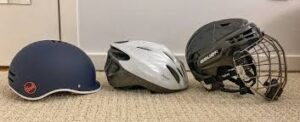Cycling is a fantastic way to stay fit, commute, and enjoy the outdoors, but safety should always come first. One of the most crucial pieces of safety equipment for any cyclist is a bicycle helmet. In this article, we’ll explore the importance of wearing a bicycle helmet, how to choose the right one, and tips for proper use and maintenance.
Why You Need a Bicycle Helmet
Wearing a bicycle helmet significantly reduces the risk of head injuries. According to safety studies, helmets can decrease the likelihood of head trauma by up to 85% in the event of a crash. Head injuries can lead to serious long-term consequences, including brain damage, so protecting your head is essential.
Choosing the Right Bicycle Helmet
Selecting the right helmet involves considering several factors to ensure it offers the best protection and comfort:
- Fit and Size: The helmet should fit snugly but not too tightly. Measure your head circumference and choose a helmet size that matches. Most helmets come with adjustable straps and retention systems to fine-tune the fit.
- Safety Standards: Ensure the helmet meets the safety standards set by organizations such as the Consumer Product Safety Commission (CPSC) in the United States or the European Committee for Standardization (CEN) in Europe. These standards ensure the helmet has passed rigorous testing.
- Ventilation: Look for helmets with multiple vents to keep your head cool, especially during long rides or hot weather.
- Weight: A lighter helmet can reduce fatigue on longer rides. However, ensure it doesn’t compromise on safety features.
- Visibility: Choose helmets with bright colors or reflective elements to increase your visibility to drivers and other cyclists, particularly in low-light conditions.
How to Wear Your Bicycle Helmet Properly
Even the best helmet won’t offer adequate protection if it’s not worn correctly. Follow these steps to ensure your helmet is properly positioned:
- Level Position: The helmet should sit level on your head, covering your forehead without tilting back.
- Strap Adjustment: Adjust the side straps to form a “V” shape under your ears. The chin strap should be snug but comfortable, allowing you to open your mouth without feeling too tight.
- Buckling Up: Always buckle the chin strap and ensure it stays securely fastened during your ride.
Maintaining Your Bicycle Helmet
Regular maintenance is key to ensuring your helmet continues to provide optimal protection:
- Cleaning: Clean your helmet with mild soap and water. Avoid harsh chemicals that can degrade the materials.
- Inspection: Frequently check your helmet for cracks, dents, or wear and tear. Replace it if you notice any damage or after a significant impact.
- Storage: Store your helmet in a cool, dry place away from direct sunlight to prevent material degradation.
A bicycle helmet is a vital investment in your safety and well-being as a cyclist. By choosing the right helmet, wearing it correctly, and maintaining it properly, you can significantly reduce the risk of head injuries and ride with greater confidence. Remember, safety comes first—always wear your helmet on every ride.


Types of Bicycle Helmets: Finding the Right Fit for Your Ride
Choosing the right bicycle helmet is crucial for ensuring your safety and comfort while riding. With various types of helmets designed for different cycling activities, it’s essential to know which one suits your needs best. In this article, we’ll explore the different types of bicycle helmets available and their specific features to help you make an informed choice.
Road Bike Helmets
Road bike helmets are designed for speed and efficiency. They are lightweight and have plenty of ventilation to keep you cool during intense rides. Key features include:
- Aerodynamic Design: Minimizes wind resistance to enhance performance.
- Multiple Vents: Ensures optimal airflow to keep your head cool.
- Lightweight Construction: Typically made from high-performance materials like polycarbonate shells and EPS foam.
Mountain Bike Helmets
Mountain bike helmets are built for rugged trails and off-road adventures. They offer more coverage and durability compared to road bike helmets. Key features include:
- Extended Rear Coverage: Provides additional protection for the back of the head.
- Visors: Helps shield your eyes from the sun and debris.
- Robust Construction: Designed to withstand impacts from falls and collisions with branches and rocks.
Commuter Helmets
Commuter helmets are ideal for urban cyclists who ride in traffic and on city streets. They balance comfort, style, and safety. Key features include:
- Integrated Visors or Brims: Offers sun protection and can be stylish.
- Visibility Features: Often come with reflective elements or mounts for lights to enhance visibility in low light conditions.
- Comfort and Ventilation: Designed for moderate ventilation and a comfortable fit for daily use.
BMX Helmets
BMX helmets are designed for BMX riders who perform stunts, jumps, and ride on dirt tracks. They provide excellent protection and a snug fit. Key features include:
- Full-Coverage Design: Protects the entire head, including the back and sides.
- Durable Construction: Made to withstand hard impacts and frequent falls.
- Minimal Ventilation: Prioritizes protection over ventilation, though some models may have limited vents.
Full-Face Helmets
Full-face helmets are commonly used in downhill mountain biking, BMX racing, and other high-risk cycling activities. They offer maximum protection for your entire head and face. Key features include:
- Chin Bar: Provides additional protection for the jaw and face.
- Complete Coverage: Covers the head, face, and sometimes the neck.
- Vents: Adequate ventilation despite the extensive coverage, designed to prevent overheating.
Kids’ Helmets
Kids’ helmets are specifically designed for young cyclists, offering safety features tailored to children’s needs. Key features include:
- Adjustable Fit Systems: Ensures a secure and comfortable fit as children grow.
- Bright Colors and Designs: Increases visibility and appeal to kids.
- Safety Certifications: Must meet safety standards to ensure adequate protection.
Multi-Sport Helmets
Multi-sport helmets are versatile and can be used for various activities, including cycling, skateboarding, and rollerblading. Key features include:
- Dual Certification: Meets safety standards for multiple sports.
- Durable Construction: Offers robust protection across different activities.
- Simplistic Design: Often lacks specialized features found in activity-specific helmets but provides general safety.
Choosing the right bicycle helmet depends on your specific needs and the type of cycling you do. Whether you’re racing on the road, tackling mountain trails, commuting through the city, or performing BMX stunts, there’s a helmet designed to provide the protection and comfort you require. Always ensure your helmet fits well, meets safety standards, and is appropriate for your cycling activities to maximize your safety on every ride.

Racing Bike Helmets: The Ultimate Guide to Speed and Safety
For cyclists who thrive on speed and competition, a racing bike helmet is an essential piece of gear. Designed to optimize performance while providing maximum protection, these helmets are a crucial investment for any serious racer. In this article, we’ll explore the key features of racing bike helmets, how to choose the right one, and why they are indispensable for competitive cycling.
The Importance of a Racing Bike Helmet
Racing bike helmets are engineered to balance aerodynamic efficiency, lightweight construction, and safety. They help reduce air resistance, allowing cyclists to maintain higher speeds with less effort. Moreover, these helmets are designed to protect against high-impact crashes, which are common in competitive cycling.
Key Features of Racing Bike Helmets
- Aerodynamic Design
- Streamlined Shape: Racing helmets have a sleek, aerodynamic shape that minimizes drag, helping you cut through the air more efficiently.
- Integrated Visors: Some models include visors to reduce glare and further streamline the rider’s profile.
- Lightweight Construction
- High-Performance Materials: Made from materials like polycarbonate shells and expanded polystyrene (EPS) foam, these helmets offer robust protection without adding unnecessary weight.
- Minimalist Padding: Lightweight, breathable padding provides comfort without adding bulk.
- Ventilation
- Strategically Placed Vents: Designed to maximize airflow while maintaining aerodynamic efficiency, keeping your head cool during intense efforts.
- Internal Channeling: Enhances airflow through the helmet, improving comfort on long rides.
- Adjustable Fit Systems
- Dial or Ratchet Systems: Allow for quick and precise adjustments to ensure a snug and secure fit.
- Strap Adjustments: Easily adjustable straps help maintain a comfortable and secure fit throughout your ride.
- Safety Standards
- Certified Protection: Look for helmets that meet safety standards such as CPSC (Consumer Product Safety Commission) or CE (Conformité Européenne) certifications to ensure reliable protection.
Choosing the Right Racing Bike Helmet
- Fit and Comfort
- Proper Sizing: Measure your head circumference and choose a helmet size that fits snugly without being too tight.
- Adjustable Features: Ensure the helmet has a good adjustment system for a secure and comfortable fit.
- Aerodynamics
- Wind Tunnel Tested: Opt for helmets that have been tested in wind tunnels for proven aerodynamic benefits.
- Shape and Design: Look for helmets with a streamlined shape that aligns with your riding position.
- Ventilation
- Climate Considerations: If you ride in hot conditions, prioritize helmets with excellent ventilation to keep cool.
- Vent Placement: Ensure the vents are strategically placed to enhance airflow without compromising aerodynamics.
- Weight
- Balance and Comfort: Choose a lightweight helmet that doesn’t sacrifice safety, ensuring you can wear it comfortably for long durations.
- Additional Features
- Visors and Shields: Some racing helmets come with removable visors or shields for added convenience and protection.
- Color and Visibility: Bright colors or reflective elements can enhance visibility, adding an extra layer of safety.
A racing bike helmet is more than just a piece of protective gear—it’s a crucial component that enhances your performance and safety on the road. By understanding the key features and knowing how to choose the right helmet, you can ensure that you are fully prepared for the demands of competitive cycling. Invest in a high-quality racing bike helmet to ride faster, safer, and with greater confidence.











